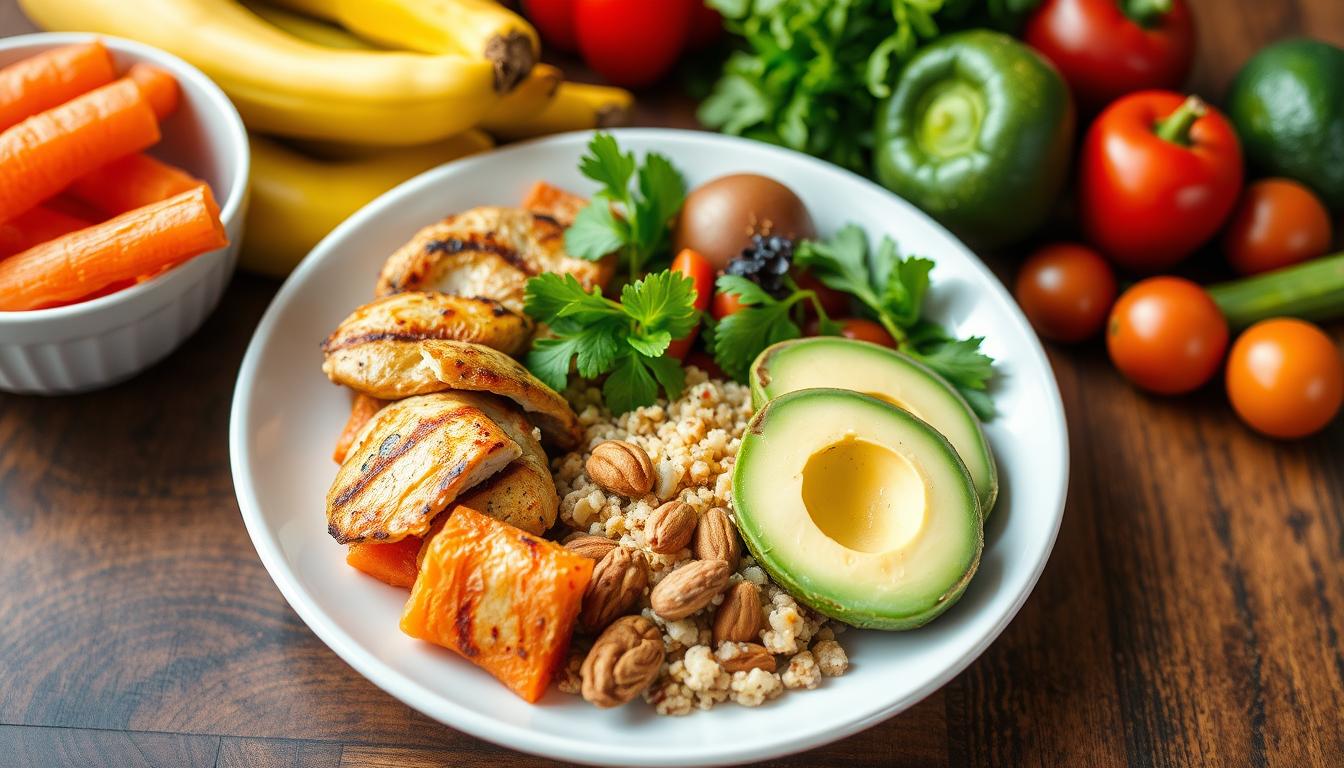Proper nutrition planning is key for optimal health and weight loss. A balanced diet with the right macronutrients is essential. It helps the body function well.
Understanding macronutrients is vital for nutrition planning. A balanced diet prevents chronic diseases and boosts energy. It also supports weight loss. By choosing the right foods, you can control your health.
To achieve optimal health and weight loss, you need to know about nutrition planning. Learning to balance macronutrients helps you make better diet choices.
Introduction to Macronutrient Balance
Knowing about macronutrients is crucial for dietary balance. Learning about their types and functions helps you make smart diet choices.
Understanding the Basics of Macronutrients
When it comes to healthy eating and weight management, knowing about macronutrients is key. Macronutrients are the main parts of our diet. They give us the energy and nutrients we need to stay healthy. Let’s explore what they are, why they’re important, and the three main types: proteins, carbohydrates, and fats.
Eating a balanced diet is important for staying healthy and managing weight. Knowing about macronutrients helps us make better food choices. This is true whether you want to lose weight, build muscle, or just stay healthy.
What Are Macronutrients?
Macronutrients are nutrients that give us energy or help our bodies grow and repair. They are called “macro” because we need a lot of them. The three main macronutrients are:
- Proteins
- Carbohydrates
- Fats
Why Macronutrients Matter
Macronutrients are crucial for our health and weight management. They give us energy, help our bodies grow and repair, and keep us healthy. Without enough of these nutrients, we can feel tired, weak, and even have trouble thinking clearly.
The Three Primary Macronutrients Explained
Each of the three main macronutrients has a special role in our diet. Knowing what they do helps us choose the right foods. Next, we’ll look at proteins and how they help with healthy eating and weight management.
| Macronutrient | Function | Food Sources |
|---|---|---|
| Proteins | Build and repair tissues | Meat, fish, eggs, dairy |
| Carbohydrates | Provide energy | Grains, fruits, vegetables |
| Fats | Provide energy, support growth and repair | Oils, nuts, seeds |
The Role of Proteins in Your Diet
Proteins are key to a balanced macronutrient ratio for good health and weight loss. The daily protein intake depends on age, sex, and how active you are. Adults should aim for 0.8-1.2 grams of protein per kilogram of body weight each day.
Eating enough protein helps with losing weight, building muscle, and staying healthy. Good protein sources include lean meats, fish, eggs, dairy, and plant-based foods like legumes and tofu. It’s crucial to choose high-quality proteins that give your body all the amino acids it needs.
Here are some high-protein foods and their protein content:
- Chicken breast: 30-35 grams of protein per 3-ounce serving
- Salmon: 20-25 grams of protein per 3-ounce serving
- Eggs: 6-7 grams of protein per large egg
- Greek yogurt: 20-25 grams of protein per 6-ounce serving
Finding the right macronutrient ratio is important. Aim for 15-20% of your calories to come from protein, 25-30% from fat, and 55-60% from carbs. But, your needs might be different. Talking to a healthcare expert or dietitian can help find the best macronutrient ratio and protein intake for you.
Carbohydrates: Friend or Foe?
Many people are unsure about carbs in their diet. Carbs are key for energy in the body. Healthy carbs help fuel workouts and daily life. It’s important to know the difference between simple and complex carbs.
Healthy carbs, like whole grains, fruits, and veggies, are full of nutrients and fiber. Simple carbs, like sugary snacks, can raise blood sugar too high. This can lead to energy crashes.
Simple vs. Complex Carbohydrates
Complex carbs, like brown rice and whole wheat bread, are full of fiber and nutrients. They give energy slowly. Simple carbs, like white bread, are quickly digested and raise blood sugar fast.
Optimal Carb Timing for Weight Loss
To lose weight, eat complex carbs at meals and snacks. Avoid simple carbs. This keeps blood sugar steady and supports a healthy carb balance. Healthy carbs also make you feel full longer, helping you eat less.
Best Sources of Healthy Carbs
Some top healthy carb sources are:
- Whole grains, such as brown rice, quinoa, and whole wheat bread
- Fruits, like apples, bananas, and berries
- Vegetables, such as broccoli, carrots, and sweet potatoes
Eating these healthy carbs helps your overall health and well-being.
Healthy Fats and Their Impact on Health and Weight Loss
Healthy fats are key to a balanced diet. They help our brains work, make hormones, and absorb vitamins. The right amount of fat can aid in losing weight and boosting health. It’s important to pick the right fats.
There are different fats like saturated, monounsaturated, and polyunsaturated. Each has its own good and bad sides. For instance, monounsaturated fats in avocados and olive oil are good for the heart.
Essential Fatty Acids
Our bodies need essential fatty acids like omega-3 and omega-6. We can’t make them ourselves, so we must eat them. Foods like fatty fish, nuts, and seeds are full of these. Eating the right fats can lower inflammation and improve health.
Choosing the Right Fats
When picking fats, choose ones that are full of nutrients but low in bad fats. Good choices include:
- Fatty fish like salmon and sardines
- Nuts and seeds like walnuts and chia seeds
- Avocados and olive oil
These foods are great sources of healthy fats. They can help make your diet balanced.
Fat Portion Control Guidelines
To keep fat intake healthy, control your portions. The American Heart Association says adults should eat 20-35% of their calories as fat. By watching your fat portions and choosing healthy fats, you can keep your diet balanced. This supports health and weight loss.
| Fat Type | Food Sources | Benefits |
|---|---|---|
| Monounsaturated | Avocados, olive oil | Heart health, weight management |
| Polyunsaturated | Fatty fish, nuts, seeds | Reduced inflammation, improved brain function |
Calculating Your Personal Macronutrient Needs
To make a good nutrition planning plan, you need to know your dietary needs. Think about your age, sex, weight, height, and how active you are. This helps you make a plan that fits you perfectly.
First, figure out how many calories you need each day. You can use online tools or talk to a doctor. After knowing your daily calorie needs, split them into protein, carbs, and fats.
- Protein: 15-20% of daily calories
- Carbohydrates: 45-65% of daily calories
- Fat: 20-35% of daily calories
By using these tips and thinking about your dietary needs, you can make a nutrition planning plan that helps you stay healthy and reach your goals.
| Macronutrient | Daily Recommendation |
|---|---|
| Protein | 0.8-1.2 grams per kilogram of body weight |
| Carbohydrates | 45-65% of daily calories |
| Fat | 20-35% of daily calories |
Keep in mind, everyone’s dietary needs are different. It might take some time to find the right mix of macronutrients for you. Always talk to a doctor or a dietitian to make a nutrition planning plan that’s just right for you.
Creating Your Balanced Meal Plan
For weight loss and health, meal planning is key. A good meal plan gives you the right nutrients your body needs. It helps you make healthy food choices every day.
A balanced meal plan has foods from all groups. Here are some tips to start:
- Begin with a healthy breakfast, like oatmeal with fruit and nuts or scrambled eggs with whole-grain toast
- Plan lunches and dinners ahead, with options like grilled chicken or fish with roasted veggies and quinoa or brown rice
- Have healthy snacks ready, like fruits, carrot sticks with hummus, or nuts and seeds
By following these tips, you’ll develop healthy eating habits. Remember, stay flexible and adjust your meal plan as needed. This ensures it works for you, not against you.
| Meal | Food Options | Macronutrient Balance |
|---|---|---|
| Breakfast | Oatmeal with fruit and nuts, scrambled eggs with whole-grain toast | Complex carbohydrates, protein, healthy fats |
| Lunch | Grilled chicken or fish with roasted vegetables and quinoa or brown rice | Lean protein, complex carbohydrates, healthy fats |
| Dinner | Grilled chicken or fish with roasted vegetables and quinoa or brown rice | Lean protein, complex carbohydrates, healthy fats |
Common Mistakes in Macronutrient Balance
Many people struggle with balancing macronutrients. They often make dietary mistakes that slow down their progress. One big error is focusing too much on one macronutrient, like protein or carbs. This can cause them to miss out on fiber and healthy fats.
Here are some common mistakes to watch out for:
- Neglecting portion control, leading to overconsumption of calories
- Not staying hydrated, which can affect macronutrient balance and overall health
- Not eating a variety of foods, leading to nutrient deficiencies
To steer clear of these dietary mistakes and nutrition pitfalls, understanding macronutrients is key. Being aware of these errors helps in creating a balanced diet. This supports health and fitness goals.
Adjusting Macros for Different Fitness Goals
Reaching your fitness goals means adjusting your macronutrients. Whether you want to lose weight, build muscle, or stay fit, knowing how to adjust your macros is key. Each goal needs a different approach to macronutrient intake. Making smart choices can help you achieve your goals faster.
For weight loss, try eating less carbs and more protein. If you’re aiming to build muscle, focus on a balanced diet with enough protein, carbs, and fats. To keep your weight and health in check, balance your macros based on your calorie needs and activity level.
- Weight loss: 1.6-2.2 grams of protein per kilogram of body weight, 2-3 grams of carbohydrates per kilogram of body weight, and 0.5-1 gram of healthy fats per kilogram of body weight
- Muscle building: 1.6-2.2 grams of protein per kilogram of body weight, 3-4 grams of carbohydrates per kilogram of body weight, and 0.5-1 gram of healthy fats per kilogram of body weight
- Maintenance: 1.2-1.6 grams of protein per kilogram of body weight, 2-3 grams of carbohydrates per kilogram of body weight, and 0.5-1 gram of healthy fats per kilogram of body weight
Weight Loss Ratios
For weight loss, aim for a calorie deficit while keeping your macros balanced. A diet rich in protein and healthy fats can help you feel full longer.
Muscle Building Proportions
To build muscle, you need more calories and protein. A diet that includes protein, carbs, and fats supports muscle growth and health.
Maintenance Formulas
To maintain your weight and health, balance your macros. Consider your calorie needs and activity level. Eating whole foods like fruits, veggies, grains, lean proteins, and healthy fats supports overall health.
Tracking and Monitoring Your Macronutrient Intake
Keeping track of your nutrition is key to a balanced diet and reaching your fitness goals. By watching your macronutrient intake, you can choose the right foods. This ensures you get enough protein, carbs, and healthy fats. Nutrition tracking can be done with apps, food diaries, or online tools.
Apps like MyFitnessPal, Lose It!, and MyNetDiary are great for tracking macronutrients. They let you log your food, set goals, and see how you’re doing. You can also use online tools, like spreadsheets or nutrition calculators, to track your intake and adjust as needed.
To make the most of tracking your nutrition, regularly check your progress and tweak your diet. Do weekly checks on your macronutrient intake, track your weight and body fat, and watch your health and fitness goals. By combining macronutrient monitoring with regular checks, you can fine-tune your diet and reach your goals.
Regular nutrition tracking and macronutrient monitoring offer many benefits. These include:
- Improved diet quality
- Increased awareness of food choices
- Enhanced weight management
- Better overall health and fitness
Conclusion: Mastering Your Macros for Lasting Results
Learning to balance macronutrients is key for good health and lasting weight loss. You now know how proteins, carbs, and fats work together. This knowledge helps you make a meal plan that meets your body’s needs and supports your fitness goals.
A healthy diet is more than a quick fix; it’s a lifestyle choice. Use what you’ve learned to track your macronutrients. This way, you can adjust your diet to keep your body nourished with the right nutrients.
Start this journey of healthy living with confidence. Soon, you’ll see better energy, a better body, and overall wellness. Mastering your macros is the first step to a life full of health and happiness.
FAQ
What are macronutrients and why are they important?
Macronutrients are the three main nutrients that give your body energy: proteins, carbohydrates, and fats. They are key for staying healthy, supporting body functions, and reaching fitness goals.
How do I balance my macronutrient intake?
To balance your macronutrients, adjust the amounts of proteins, carbohydrates, and fats. This matches your needs and fitness goals. Meal planning and tracking your intake help a lot.
What are the best sources of protein, carbohydrates, and healthy fats?
Good protein sources include lean meats, eggs, dairy, legumes, and plant-based options. Choose complex carbs like whole grains, fruits, and veggies over simple sugars. Healthy fats are in nuts, seeds, avocados, and fatty fish.
How do I calculate my personal macronutrient needs?
Your macronutrient needs depend on age, sex, weight, height, and activity level. Use online calculators or talk to a registered dietitian to find your ideal ratios.
What are some common mistakes people make when trying to balance their macros?
Mistakes include focusing too much on one macronutrient, ignoring portion sizes, not drinking enough water, and not adjusting macros as goals change.
How do I adjust my macros for different fitness goals?
For weight loss, eat more protein and less carbs. For muscle building, increase protein and calories. Adjust your diet to match your fitness goals.
What are the best tools and methods for tracking my macronutrient intake?
Use apps, food journals, and check your progress regularly. Watch portion sizes and review your diet weekly to stay balanced.



